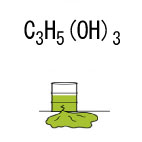| Case Name |
Leakage and fire damage caused due to stress corrosion cracking of a heat exchanger at a glycerin concentration plant |
| Pictograph |

|
| Date |
July 5, 1996 |
| Place |
Amagasaki, Hyogo, Japan |
| Location |
Chemical factory |
| Overview |
A crack was generated at a heat exchanger of a glycerin water concentration plant. The crack was parallel to the weld line. Therefore, glycerin leaked and thermal insulation was damaged by heat. The cause is regarded to be stress corrosion cracking due to residual stress. |
| Incident |
Glycerin leaked from a heat exchanger of a concentration plant for glycerin water. While the heat exchanger for heating glycerin water was being operated as usual, insulation damage caused by fire was found with glycerin leakage and burns around the end plate. |
| Processing |
Manufacture |
| Individual Process |
Evaporation |
| Substance |
Glycerin, Fig2 |
| Type of Accident |
Rupture, Leakage, Fire |
| Sequence |
On July 5th, 1996. A glycerin concentration plant was operated as usual. Fire damage to thermal insulation was found with a glycerin leak around the endplate of a heat exchanger.
On July 6th. The leak was temporarily fixed by spreading "Super metal" on the leaking part.
On July 8th. The maker confirmed a longitudinal crack (length of 2-3 mm) around the endplate, 3 mm apart from the weld line between the end plate and the body.
On July 18th. "Super metal" was again spread on the cracks.
"Super metal" is the brand name of an emergency repair material. |
| Cause |
Cracks were generated where heat influenced weld line. As it was stainless steel processed for fabrication, it was assumed stress corrosion cracking due to residual stress. |
| Response |
"Super metal" was spread on the crack. |
| Countermeasures |
A performance test and a check are always carried out. |
| Knowledge Comment |
The pressurized heat exchanger receives influences of heat and pressure.
As a heat exchanger is usually covered with thermal insulation, and does not have rotating parts, checks tend to be simplified easily.
Checks of material itself require time and effort.
As a leak does not occur if a crack does not penetrate, cracks and openings are not found by a leak test alone. |
| Background |
A performance test on the heat exchanger was executed every year after completion in July, 1984. No abnormalities were found at the last monthly check on June 15th. |
| Reason for Adding to DB |
Example of leakage caused due to stress corrosion cracking |
| Scenario |
| Primary Scenario
|
Poor Value Perception, Poor Safety Awareness, Countermeasure against Stress Corrosion Cracking, Planning and Design, Poor Planning, Poor Design, Production, Hardware Production, Equipment Production, Failure, Fracture/Damage, Crack, Secondary Damage, External Damage, Leakage
|
|
| Sources |
Res. Inst. of Industrial Safety material (closed)
|
| Physical Damage |
Cracks around the end plate of a heat exchanger.
Fire damage to thermal insulation. |
| Multimedia Files |
Fig2.Chemical formula
|
| Field |
Chemicals and Plants
|
| Author |
ITAGAKI, Haruhiko (Japan National Institute of Occupational Safety and Health)
TAMURA, Masamitsu (Center for Risk Management and Safety Sciences, Yokohama National University)
|